How to Create Content Briefs [Free Template + Checklist]
Wondering why content briefs are important and how you can go about creating them?
You’ve come to the right spot.
Figure this — you might have wanted your content to go in a certain direction, but without instructing your writer well, it might go in a completely different direction.
The result?
The writer would have to rework the content and you’d end up spending a lot more time on it than you’d have planned.
That’s where a content brief can help you clearly communicate your requirements.
But what exactly is it all about and how can you create one?
Let’s find out.
![How to Create Content Briefs [Free Template + Checklist]](https://seobuddy.com/blog/wp-content/uploads/2023/05/how-to-create-content-briefs-1024x1024.png)
What Are Content Briefs?
In simple words, content briefs include a set of requirements that serve as a guide for your writers while they create content.
The biggest differentiating factor for content briefs is that they’re well documented. This means that every bit of instruction is clearly communicated.
As a result, it serves as a record that dictates exactly what was expected from the content.
So, where can you use these content briefs?

Content briefs can be used for pretty much any content type, including
- Blog posts
- Ebooks
- Case studies
- Whitepapers
- Product pages
- Landing pages
- Any other content related to SEO
And that’s what makes them so useful and integral to the content marketing process.
So, if you’re planning on creating content in the form of blog posts, ebooks, etc., it’s recommended to create a content brief for it first and if you don’t have the time to go about it, we can help.
And now onto the next step.
What Information Should You Include in a Content Brief?
The best part about a content brief is that it offers a lot of flexibility in terms of the information you can include in it. You can give as little or as much information to it as you deem necessary.
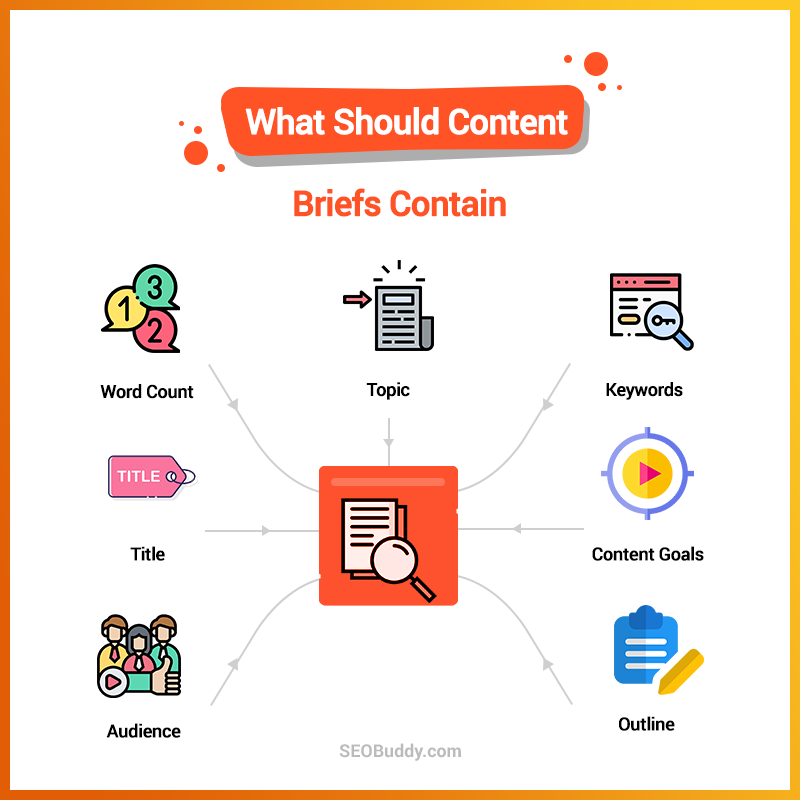
Some of the basic things that you must add to a content brief include:
- Word count
- Topic
- Keywords
- Title
- Content goals
- Audience
- Outline
Apart from these basic details, you could also include:
- Deadlines
- Background research
- Links to references
- Style guide
- Format and tone
- Guidelines to match search intent
- CTA for the audience
- Visual elements guidance
But this list doesn’t end here. There are a lot more elements that need to be included in the content briefs. Additionally, it’s important to know how to find and define each element in the brief too and that’s where our checklist can come in handy.
Now that you know all about content briefs, let’s take a look at why they’re all that important when it comes to content marketing.
Advantages of Content Briefs
Unwanted back-and-forth while creating content, solely because guidelines weren’t understood, can be a cause of frustration for any content marketer. It could be equally frustrating for the writer who has to rework the content to make amends.
And that’s where content briefs can help by bridging the communication gap.
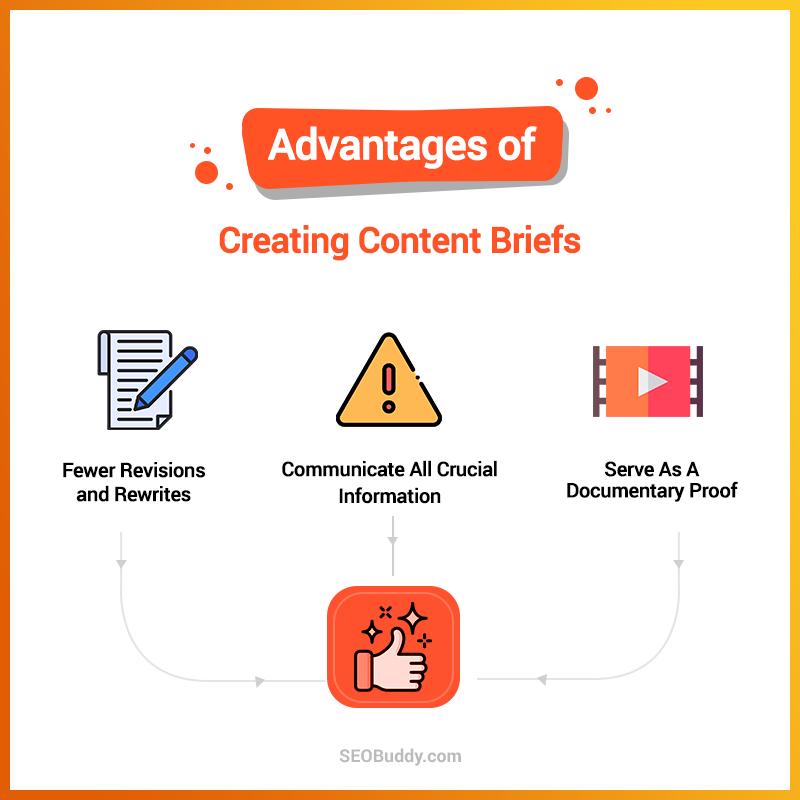
But why should you consider creating content briefs or leverage a content brief creation service like ours?
Let’s take a look at the advantages that content briefs bring along with them to understand why you need them.
Fewer Revisions and Rewrites
As mentioned before, content briefs ensure that all the instructions and guidelines are clearly communicated to the writers. This means that the entire content team would be on the same page with regards to the content that’s going to be created.
You wouldn’t have a miscommunication on topics like
- Who’s the target audience for the content?
- What’s the intent of the content?
- How detailed does the content need to be?
- Which keywords need to be added to the content?
This, in turn, reduces the chances of massive rewrites as the content would be on the lines of what is expected from the writers. Additionally, it would reduce the number of rounds of revisions as well.
Serve As Documentary Proof
Content briefs serve as documentary evidence to prove what was communicated to the content team. This can prove to be especially useful in a remote work environment where communication transcends channels.
You could be communicating with your team through multiple modes of communication. In such a case, there would be no single place where you’d have documented the guidelines.
Content briefs help avoid such a scenario by serving as the go-to destination for all the information related to a particular content piece.
(Want to see the impact a content brief can make? Get in touch with us for our content brief creation services.)
Communicate All Critical Information
It can be easy for a writer to miss out on some critical information related to the content they need to create, especially if there’s a lot that they need to cover.
Without a specific go-to resource, they’d find it challenging to remember every little thing that you might have communicated to them.
And how do content briefs help here?
Content briefs serve as the go-to resources for finding all the critical information. You could think of them as checklists for the content piece.
For instance, you could easily give your writers guidelines that can improve your content’s SEO.
(Get all the information you need about content briefs from our content brief checklist and template.)

Now it’s time to discover the other 102 steps that will get more organic traffic flowing to your website. Get the SEO Checklist here.
Want to get a sneak peek of what it looks like?
Enter your email and get a free demo version of the SEO Checklist.
When Should You Use Content Briefs?
Content briefs have loads of advantages and you can pretty much use them for every piece of content that you create. However, that’s not a necessity. You could choose not to use them as well.
However, in certain cases, you shouldn’t move ahead without content briefs at all costs.
Here are the situations where you must create content briefs and share them:
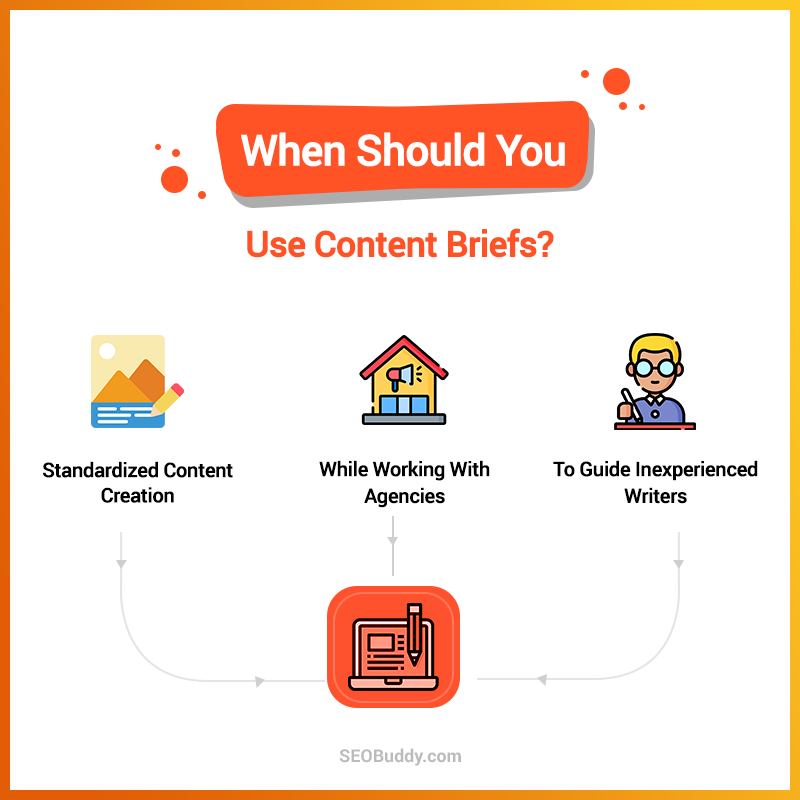
1. Standardized Content Creation
When you’ve got a standardized type of content, which requires specific formatting, content briefs make sense. The main reason here is that the content would have the same structure every time. Making a template would make the writer’s job easier here. Examples of such content would be listicle posts.
2. Instructing Agencies
If you’re working with agencies for your content creation and promotion, you need to be clear about your requirements.
The reason?
Agencies are likely going to be working with a large number of clients like you. This would mean that their writers would be working on different types of content all the time.
In such a situation, they may not remember specifics related to your content. Content briefs can come in handy here.
(Interested in trying your hand at creating a content brief? Check out our detailed checklist and template.)
3. Guiding Inexperienced Writers
Working with experienced writers is simple. They’d be well-versed with your content requirements and wouldn’t need a guiding document like a content brief.
That’s not the case with inexperienced writers.
You need to ensure that they’ve got everything they need to deliver content that you expect from them, such as avoiding plagiarism. Content briefs can help them understand your voice, audience, keywords, and goals with ease.
How to Create Content Briefs
Now that you know all about content briefs, it’s time to understand how you can create one for your business.
Let’s get started.
1. Word Count
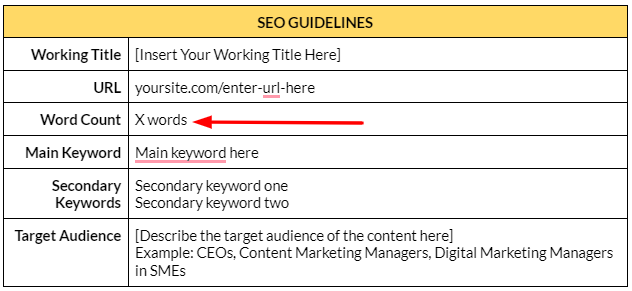
The first step is to clearly specify what you expect in terms of the content length.
The reason?
The word count of content determines how in-depth you want the content to be.
You need to clearly state this word count range for your writers in the content briefs.
But how do you find this word count?
Well, for one, according to a study by Backlinko, the average post on the first page of the SERPs is about 1,447 words long.
But here’s the thing — this may or may not be the case with your post. Here are the various factors to consider while finding the word count of your post
- Authority: You need to find your domain authority using a tool like Moz ($99/month). A higher domain authority than the current SERP rankers would mean that you can write slightly shorter posts. But lower DA would mean that you’d need to write longer ones.
- Keyword Difficulty: Some keywords are more competitive than others. The keyword difficulty score can be found using Semrush ($119.95/month) or Ahrefs ($99/month). The higher the score, the longer your content will need to be.
- Average Word Count: You need to scrape the SERP using a tool like Frase ($25/seat/month) to see the average word count of the ranking pages.
- Competition: See the competition level by checking the authority of all the ranking pages in the SERPs to determine if you need to write posts longer than theirs.
As you can see, most of the tools cost a lot of money in terms of monthly subscription fees. Add to that the fact that you need to invest a lot of time and effort into finding the word count. In such a situation, our content briefs service comes out to be a cost-effective option for you for just $49.
We use specialized tools to analyze SERPs and combine it with our proprietary strategy to help you find the right target word count for your content.
2. Title

You need to specify the title of the content that you want from your writers. This could be a working title and the idea behind it would be to help the writer get an idea of what needs to be written.
In addition to that, you could include a single sentence description that can tell the writer what they need to convey through the piece.
Here are some things that you should consider when writing the title:
- Determine the SERP intent to understand what the content needs to be about and use it to frame your title.
- It should contain your target keyword, preferably towards the beginning.
- You can consider adding numbers to it
- Ensure that the title isn’t very long (<60 characters) as it might not show up fully in the SERPs.
- Shouldn’t be similar to the title of another page on your website.
- Can consider adding your brand name.
- Run the title through a title checker or headline analyzer tool to see if it’s well-optimized.
One thing to note here is that the title that you’ll add to the content briefs is the working title. It’s not necessary to use the same for publishing the post. It can always be modified at a later stage once the content is written.
PS: Finding the SERP intent is slightly tricky. You’d need to manually analyze the search query and understand what might be the intention behind it.
This is best left to experts as a skewed search intent would mean failure, irrespective of how good your content is. We cover this aspect in our content briefs service too.
3. Keyword Suggestions
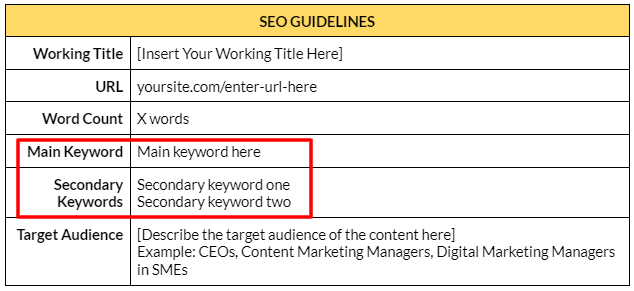
You should also add keyword suggestions that you’ve got from keyword research to your content brief in the order of priority. Make sure you clearly specify the main target keywords and also highlight the secondary keywords.
What’s more?
It also helps to highlight any other requirements with relation to the keywords. For instance, where you want them to be used or their density.
This step requires SEO expertise and a powerful tool stack (which is pretty heavy on the pocket). This makes content brief creation services a more viable and cost-friendly option.
However, if you still want to give it a shot, you’ll first need to come up with a primary search term for your keyword research.
Next, find a reliable keyword research tool like Semrush or KWFinder. You’ll need to search using the primary search term to get a list of the potential keywords for your content.
You’ll then need to go through this list and analyze the keywords based on their volume, keyword difficulty, CPC, and more, to determine your target keyword and secondary keywords.
What’s more?
It’s also important to find LSI keywords. And you can do this by looking at the bottom of the SERPs when you search for your primary keyword on Google.
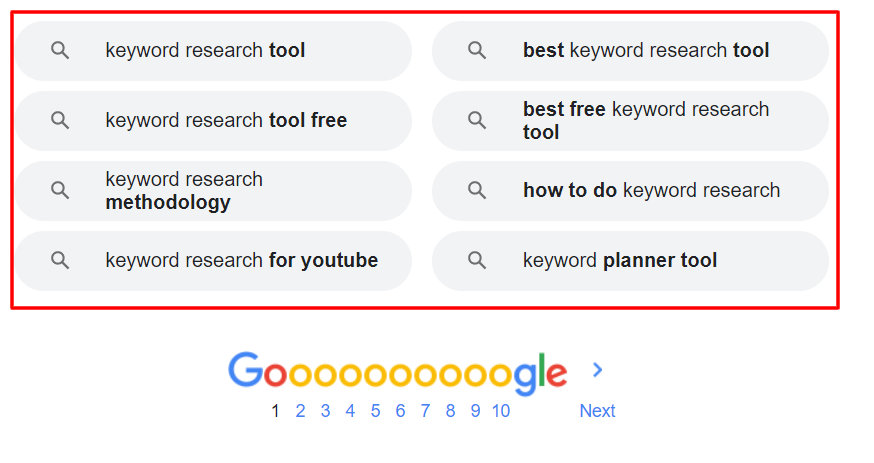
4. Target Audience
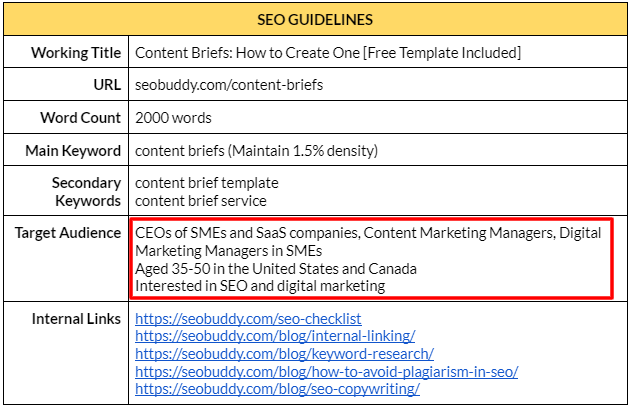
No content piece can perform well if you don’t write it directly for the target audience. That’s why it’s crucial to mention the intended audience of your post in the content briefs that you provide to your writers.
Here’s what should be included in the target audience section:
- Age range
- Designation
- Language
- Organization size
- Location
- Behavior
- Interests
- Social channels they use
- Problems
- Other demographic, geographic, and psychographic factors.
(Want a DIY checklist and template for creating your content brief? You can get it here. And if you’re pressed for time and you’d like us to take care of it, get in touch now.)
5. Tone
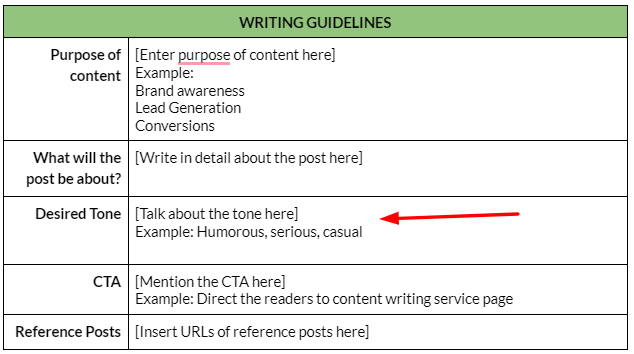
It’s essential to specify what tone you want the writer to adopt for the content.
Would you like the content to have a formal tone? Or perhaps, a lighter tone with some humor?
You should specify the same in your content brief based on the target audience’s tastes.
This tone can be picked up from your style guide and must also be based on the target audience for the particular content piece that you’re creating.
6. Reference Posts
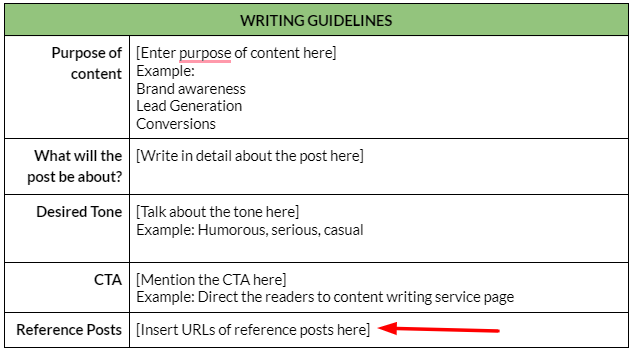
If you’ve got some reference posts for your writers to see, you should include the links to these external resources in your content briefs as well.
Now, this is the part where you’ll have to invest a lot of time as finding good content that your writers can use to create your content can be a challenge in itself. You’ll need to take the time out to thoroughly research the topic.
The resources that you add could be valuable blogs, infographics, videos, etc. You could also consider adding links to relevant statistics and examples that could possibly be added in the content.
Pro Tip: Do note that you shouldn’t take everything in the SERPs at face value. It’s not necessary that everything that’s listed in the SERPs is correct.
(Want us to take care of it all? Get in touch with us for our content briefs service.)
7. Internal Links
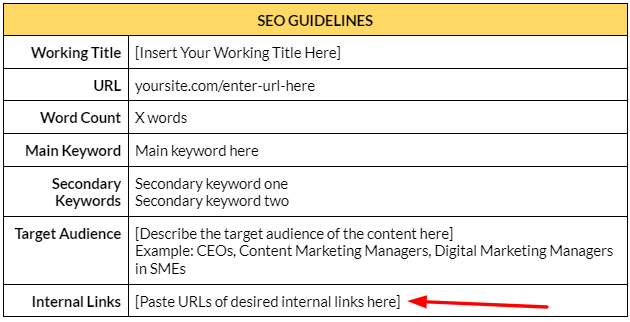
Internal links play an important role in content and SEO. If there are some specific internal resources that you’d like the writer to link to in the content, you should specify them in the content briefs.
But what if you want to give them the flexibility?
You can do that as well. However, in this case, you should add guidelines related to internal link addition.
And how do you select which internal links need to be added to the content?
Start by understanding the topic of your content and then take a look at the outline you’ve created.
Next, based on the content topic and the various sub-headings, start searching for relevant posts on your website. You can then pick a few relevant posts and add their URLs to the content briefs.
A tip here — for longer posts, make sure you add more internal links.
8. Client Guidelines
This is particularly an important section that needs to be added to your outline if you’re an agency. Your writers need to know everything about the clients, as they likely write for a number of different clients.
That’s why it’s essential to add information like:
- Client name
- Links to previous posts on the client’s website
- Major competitors
- Specific writing guidelines (US English, UK English, etc.)
And if you find it challenging to identify this information for creating your content brief, you can leverage our content brief creation service. We’ll handle it all for you for just $49.
9. FAQ Addition
Along with your SEO guidelines, it’s also important to mention the frequently asked questions (FAQs) in your content briefs.
The reason?
FAQs can help your content rank in the SERPs and show up as rich results. When you add the FAQ schema to your content, it will likely show the FAQs below your SERP listing.
What’s more?
Adding FAQs to your post can also increase your chances of getting listed in the “People Also Ask” section of the SERPs. This, in turn, can further increase the chances of driving traffic to your website.
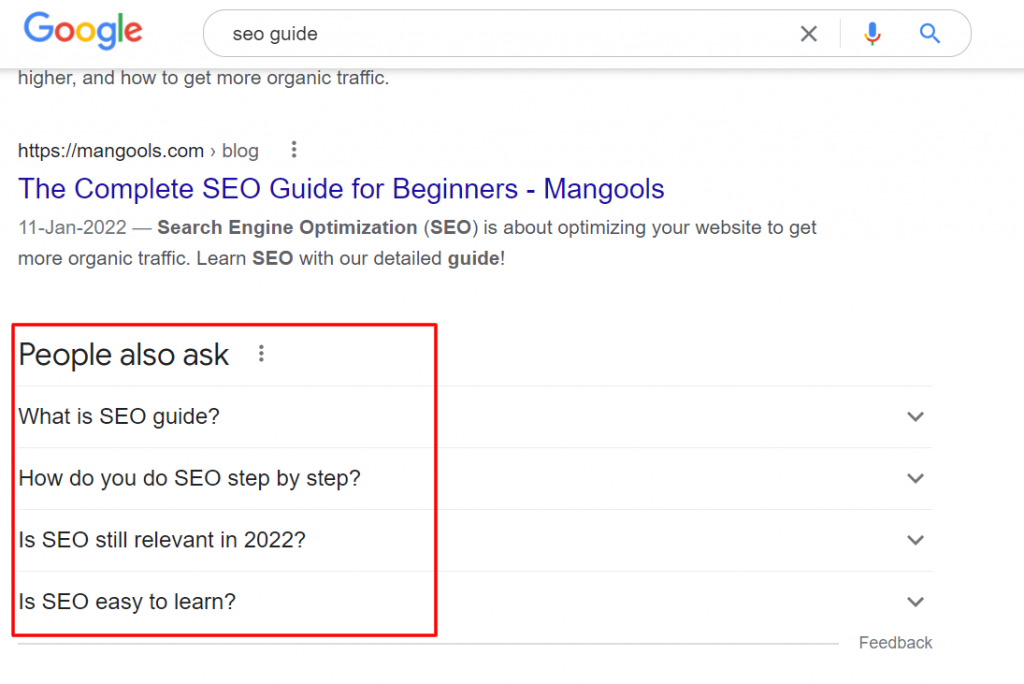
And now for the all-important question — how do you find the FAQs?
To start, you could head to Google and search using your target keyword. Then, you can look for the People Also Ask section in the SERPs and select questions from there.
Additionally, you could refer to the SERP competitors to figure out the FAQs that they’ve written. You could take inspiration from there as well.
You can also leverage tools like Semrush ($119.95/month) and Ahrefs ($99/month). These tools show you question-type keywords when you conduct keyword research using them. You can pick our FAQs from these as well.
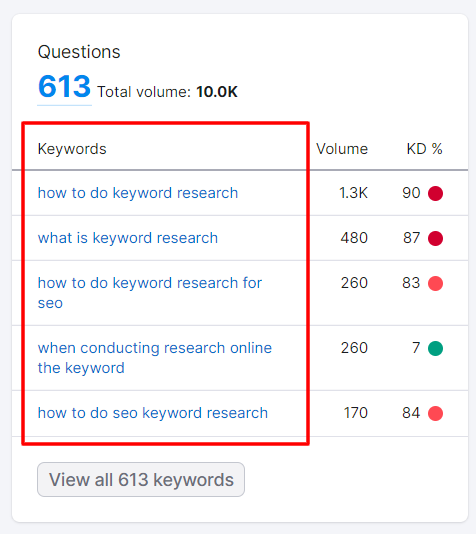
Finally, you could rely on tools like SurferSEO ($49/month) that can show you the most important FAQs that you could include in your content.
(PS: We do include FAQ suggestions when we create content briefs for you.)
10. Outline
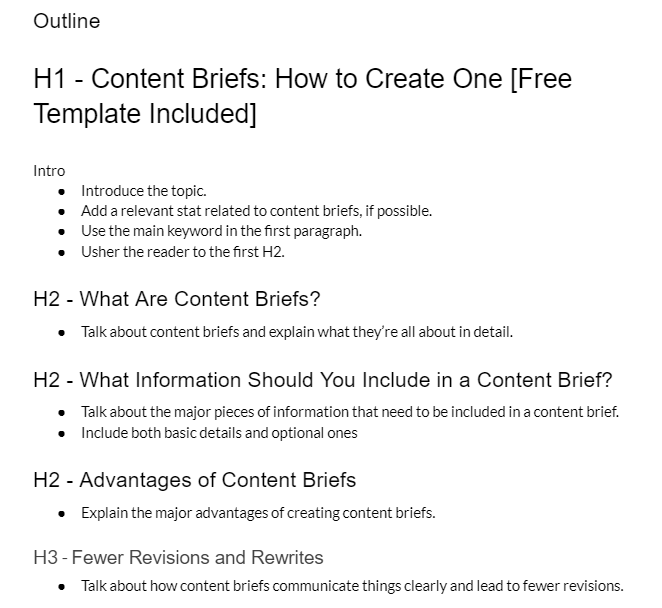
One of the most important things that you should consider adding to your content brief is the outline for your content.
And why is that?
It gives the writer a wireframe structure to work on and makes their job easier.
What’s more?
They’ll know exactly what you want the content to look like and this drastically reduces the chances of rewrites and rework.
But how do you decide on what to include in your outline and how to structure it well?
- Conduct SERP analysis using your target keyword to understand what others have included in their content.
- Structure the outline with H1, H2, H3, and so on.
- Use bullet points to elaborate on what needs to be written in each sub-heading.
- Create a short outline with just sub-headings if you want to give writers the flexibility on what to write.
- Prepare a detailed outline with bullet points and links to examples and statistics if you’ve got a rigid structure that you’d like your writers to follow.
- While manual SERP analysis is great, it’s quite time-consuming. Add to that the fact that you might encounter some poor content as well. AI-powered outline generators like SurferSEO ($49/month) can help here. However, you’ll still need to review the outline manually to understand if it’s satisfying the SERP intent.
Let’s take a look at these AI-powered tools in the next section.
Using Tools for Your Content Brief
As mentioned above, there are several tools that can give you insights into your competitors in the SERPs. This, in turn, can help you understand their content strategy and discover tactics that you can use to outrank them.
Some of the tools you can leverage include SurferSEO, Clearscope, and Frase. These tools scan the SERPs and provide detailed insights into the content created by your competitors. This includes:
- Insights into the average word count
- Keyword related insights, including keyword type
- Outline insights, including AI-powered outlines
- FAQ suggestions to understand which questions need to be answered in the post
- Topic ideas based on the keyword entered
These insights can be leveraged to create your content brief.
But these tools can be costly if you’ve not invested in them yet. Additionally, leveraging the tools alone won’t help you. Along with it, you’d need to put some level of manual effort into keyword research, audience research, internal linking, and more.
And this process is time-consuming.
However, we’ve got a complete stack of tools and a team of experienced experts to take this load off your shoulders. Our team can create content briefs for you at just $49.
But if you’d still like to try your hand at doing it yourself, you can download our checklist and template as well.
FAQ
1. What should be included in a content brief?
Some of the things you should include in a content brief are:
- Word count
- Topic
- Keywords
- Title
- Content goals
- Audience
- Outline
2. How do you write a content brief?
You can write a content brief by following the below steps:
- Add the working title
- Mention the word count
- Include keywords and secondary keywords
- Add the outline
- Mention the target audience
- Include internal links
3. What is a content brief?
A content brief is a document that serves as a written instruction for a writer. It serves as a guide for them when they create content. A content brief contains all the relevant information that a writer would need to create content just the way the content manager wants.
4. How long should a brief be?
The best part about content briefs is that their length is completely up to you. You can make them as descriptive or short as you want. However, try to wrap them up in two pages.
5. What does a content brief look like?
A content brief typically looks like a document that contains information about elements that make up a content piece.
Final Thoughts
Content briefs play a major role in helping you implement your content marketing strategy to perfection.
Through them, you can convey your requirements to the writers. As a result, you can expect a reduction in the number of rewrites as well.
Some of the important things you should add to a content brief include the title, keywords, outline, target audience, and more.
And now, if you’re wondering what your content brief should look like? Fret not. We’ve got you covered.
We’ve created a comprehensive content brief template and checklist that you can use to create a brief for all your posts. You really just need to edit it and you’re ready to go. It’s that simple!
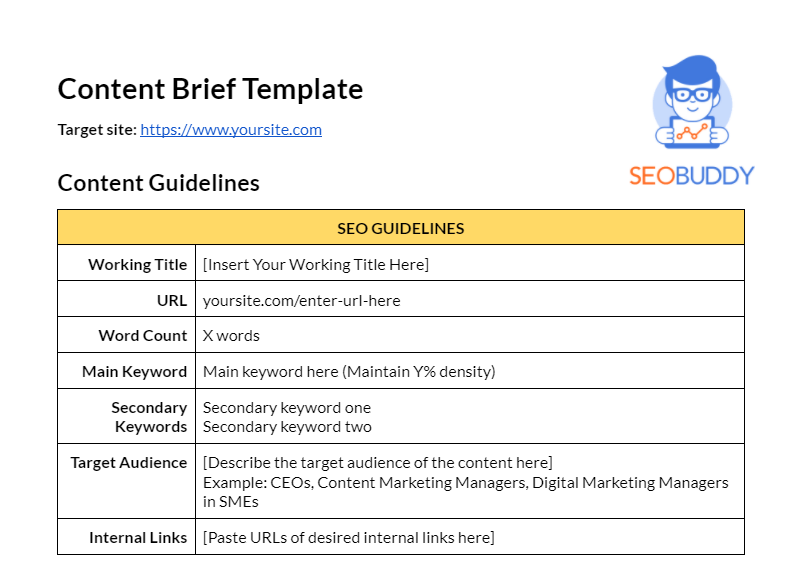
That said, creating a content brief is time-consuming, especially when you’ve got a large volume of posts to create. That’s where we can help. Get in touch with our team now to leverage our content brief creation service starting at $49 only!



